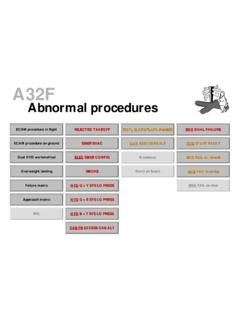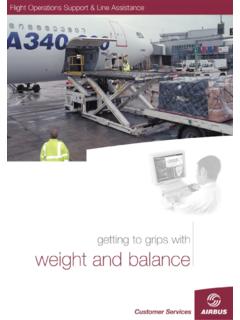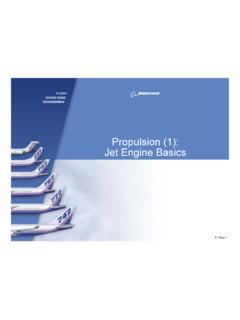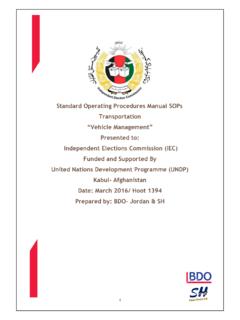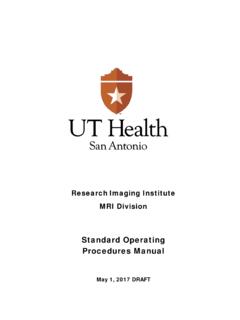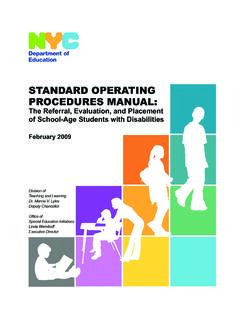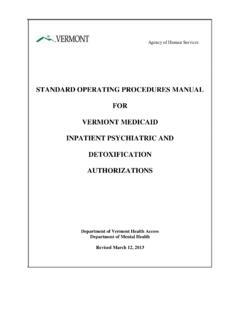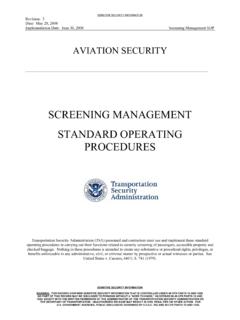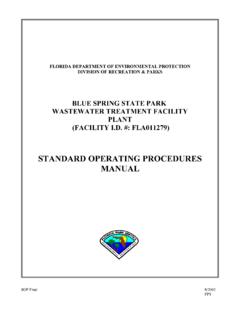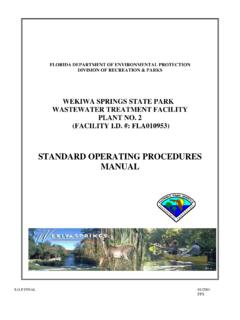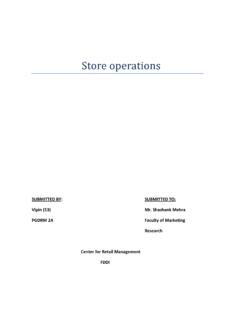Transcription of STANDARD OPERATING PROCEDURES MANUAL - …
1 STANDARD OPERATING PROCEDURESMANUALEMPRESA BRASILEIRA DE AERON UTICA MANUAL IS APPLICABLE TO ALL 120/1624 MAY 31, 2002 CUSTOMER COMMENT FORMS tandard OPERATING PROCEDURES ManualSOP 120/1624 Please use this Customer Comment Form to notify us ofany discrepancies or problems you find in the StandardOperating PROCEDURES . We would also welcomeconstructive suggestions on how we can further improveour documentation or feedback will be acknowledged, and we will adviseyou of the action we intend to ,Embraer Operations SupportPlease return this form to:Embraer - DST/GSO/SEO - PC176Av. Brigadeiro Faria Lima, 2170 CEP 12227-901S o Jos dos Campos - SP - Box 8050 Phone:+55 12 3927-1706 Fax:+55 12 OPERATING PROCEDURES ManualSOP 120/1624 Section/Page:Date of Page:Revision:Name:Position:Company:Fax Number:Phone Number:e-mail:Comment/Suggestion:Space reserved for EmbraerCCF n :Comment received: Date Acknowledged:Person in Charge:Action to be taken:Proposed date for implementation:Implemented.
2 LIST OF EFFECTIVEPAGES* Asterisk indicates pages revised, added or deleted by the current 31, 2002 ALIST OF EFFECTIVE 31, OF EFFECTIVEPAGES* Asterisk indicates pages revised, added or deleted by the current 31, OF CONTENTSMAY 31, 2002iTABLE OF of and OF CONTENTSMAY 31, 2002ii1 THIS PAGE IS LEFT BLANK INTENTIONALLYINTRODUCTIONMAY 31, 20021-1 SECTION On Board Checklist 31, 20021-21 THIS PAGE IS LEFT BLANK INTENTIONALLYINTRODUCTIONMAY 31, 20021-3 INTRODUCTIONGENERALThe purpose of this MANUAL is to serve as a guideline for theimplementation of safe and efficient operation PROCEDURES for use of this MANUAL is optional. It is not a replacement for any of theoperational manuals required by applicable regulations such as theAirplane Flight MANUAL or the Company Operations underlying philosophy behind the OPERATING framework of thisManual is based on reducing as much as possible the operationalshortcomings related to human factors, namely: Improper coordination among flight crewmembers Improper coordination between flight and cabin crewmembers Distraction from basic flying tasks Misunderstandings Perplexity Tunneling ObsessionThe Philosophy of Operation Section has directives that are principlesrelating to how the operation should be conducted in its broadestsense.
3 Topics like Task Delegation, Teamwork principles andPrerogatives of a Copilot are included OPERATING Policies Section has OPERATING guidelines that are notprocedures to be followed. They are rather rules to be observed shoulda specific situation arise regardless of when and where it occurs duringthe flight. Topics such as handling of the autopilot and task sharingwhen hand flying the aircraft are covered Normal PROCEDURES Section basically presents the AFM NormalProcedures in a far more detailed manner. The intention is to eliminateany doubts regarding Flight standards that may arise during theoperation of the aircraft or during simulator 31, 20021-41 This SOP is optimized for passenger-carrying operation in a regionalairline environment. It assumes that the cabin crew is on board andthat there are procedure phase is started presenting a proposed checklistfollowed by a thorough explanation of the PROCEDURES for that checklist is supposed to be routinely used on board and itsconception was based on the following principles:THE ON BOARD CHECK LIST CONCEPTThe use of the on board check list is based on the assumption thatboth pilots have been properly trained on the type of aircraft andtherefore have a thorough knowledge of the airplane s systems andprocedures.
4 It further assumes that they know the consequences oftheir actions (or the consequences of not performing the right actionsat the right time).The on board check list is just a memory aid to assist the pilots so theydo not forget actions which, if not carried out, can in one way oranother result in some type of risk to the aircraft, to the operationalenvironment, to any of its systems, to its occupants or to thepassengers PROCEDURES to be carried out in each phase are not restricted tothe checklist. These PROCEDURES are explained in detail after eachphase checklist and are consistent with the PROCEDURES set forth in any discrepancy between the SOP and the AFM be detected,the AFM DEFINITIONSMAY 31, 20022-1 SECTION 2 BASIC DEFINITIONSMAY 31, 20022-2 THIS PAGE IS LEFT BLANK INTENTIONALLYBASIC DEFINITIONSMAY 31, 20022-3 BASIC DEFINITIONSINTRODUCTIONThe Definitions herein exist for the sole purpose of making the text inthis MANUAL unequivocal and clear.
5 They do not replace or invalidateany OPERATING Rules in force. Should there be differences betweenthese Definitions and the Regulations, the Regulations must OF RESPONSIBILITYC ockpit panel and console areas that are operated by a specific areas exist for the sake of crew coordination and a pilot mustalways advise the other pilot if he is intending to operate something inthe other pilot's Area of Responsibility. Refer to the OPERATING PoliciesSection to determine what areas are assigned to which CREWC rewmembers that handle all the occupants of the aircraft, with theexception of other crewmembers, during a flight operation. The cabincrew is composed of Cabin AND RESPONSEA Check List usage technique that consists of completing all the checklist actions by memory and verifying them item by item afterwards byreading and CABIN ATTENDANTC rewmember that reports to the Pilot-in-Command and is in charge ofassuring the safety of the occupants that are not crewmembers in allcircumstances.
6 The Chief Cabin Attendant is responsible forcoordinating with other cabin attendants the efficient handling of non-crewmember that is not in command but can carry out the duty of flying theaircraft under circumstances established by company DEFINITIONSMAY 31, 20022-4 FLIGHT CREWC rewmembers that conduct the airplane s flight OPERATIONAn operation whose intention is to fly the FLIGHT ABNORMALITYA situation that, if not handled with the appropriate PROCEDURES , maydevelop into an imminent flight safety FLIGHT EMERGENCYA situation where there is an imminent flight safety PILOTP ilot that acts both as Safety Pilot and as Flight Instructor to a not-yet-qualified pilot or to a qualified pilot undergoing flight instruction forrefreshment or for any other (LINE ORIENTED FLIGHT TRAINING)Simulator training session where the focus is on reproducing anenvironment as similar as possible to the airline OPERATING environmentwith similar workload, including all chores that are part of the normalrevenue routine.
7 The objective of these sessions is to identify areas ofdifficulty related to crew coordination and ergonomics. LOFT sessionsmay include abnormal and emergency situations that require rule-based action or knowledge-based action by the ITEMSI tems of the Check List that must be memorized by the Flight Crewand whose execution must be carried out immediately should thecorresponding Check List become legally responsible for the operation of the aircraft and whocommands the operation of the aircraft. He has the power to takeaction, to request action by the other pilot or to prevent the other pilotfrom acting as he finds appropriate for the sake of flight DEFINITIONSMAY 31, 20022-5 READ AND DOA Check List usage technique that consists of reading andaccomplishing each of the check list TO CREWMEMBERSCPT: Pilot-in-commandF/O: CopilotC/F: Refers to both pilots in generalPF: Flying PilotPNF: Non-Flying PilotF/A: Any Cabin Attendant in generalCCA.
8 Chief Cabin AttendantSAFETY PILOTThe pilot in charge of ensuring that no flight operational situation everdevelops that places flight safety at COCKPITThe principle of restricting cockpit and cockpit/cabin talk strictly to whatis required for the Flight Operation and for the safety of the DEFINITIONSMAY 31, 20022-6 THIS PAGE IS LEFT BLANK INTENTIONALLYPHILOSOPHY OFOPERATIONMAY 31, 20023-1 SECTION 3 PHILOSOPHY OF OPERATIONC ompany and and OFOPERATIONMAY 31, 20023-2 THIS PAGE IS LEFT BLANK INTENTIONALLYPHILOSOPHY OFOPERATIONMAY 31, 20023-3 PHILOSOPHY OF OPERATIONCOMPANY RULESCOMPLIANCE WITH OPERATING DIRECTIVESC rewmembers must abide by the OPERATING rules and directives thatare in force. Not being in agreement does not entitle any Crewmemberto disobey or deviate from crewmembers can depart from them if flight or passengersafety is negatively affected by their and directives can not be disregarded in the name of thefriendliness to passengers or to anybody.
9 So as an example anyOfficial Rule or Company Rule regarding admission of passengers tothe cockpit must be strictly MUST BE BEYOND DOUBTIf this MANUAL is not clear about who does what or who has theauthority to act in any situation that may arise during Flight Operation,then the MANUAL must be revised so that this omission is OF THE PILOT-IN-COMMANDHe is always the Safety Pilot. He is ultimately responsible for whateverhappens to the occupants, to the aircraft or to any goods or personsoutside the aircraft as result of the flight operation under Pilot-in-Command must use crew resources in the most effectiveway and must encourage the other crewmembers to engage inteamwork by allowing them to participate and give suggestionswhenever useful for the execution of the must treat all crewmembers with respect and consideration at RIGHTS AND DUTIESThe Copilot can be designated as PF for any flight leg if the Pilot-in-Command finds it OFOPERATIONMAY 31, 20023-4 The Copilot can and should immediately advise the Pilot-in-Commandof any operational discrepancy that may develop into a flight safetyproblem.
10 This entitlement to intervene must be practiced extensively inthe Simulator so that the Copilots understand how and to what extentthis intervention is to be exercised. Should the Pilot-in-commandbecome incapacitated, the Copilot acquires all the rights and duties ofthe AND RELATIONSHIPFLIGHT CREW COORDINATION WITH CABIN CREWMORE THAN A COURTESY, BRIEFING OTHER CREWMEMBERSIS INSTRUMENTAL TO EFFICIENT TEAMWORKPHILOSOPHY OFOPERATIONMAY 31, 20023-5 The Flight Crew must be trained on coordination with the Cabin Crewmembers must understand situations such as sterilecockpit, calls from the cockpit, pilot incapacitation and other specific in-flight situations where the participation of the Cabin Crew isinstrumental. It is recommended that joint training sessions be carriedout to practice this coordination. These joint training sessions can beLOFT RELATIONSHIPC rewmembers should never be rude or harsh to anybody when on dutyunless there is an undeniable practical reason to act in such a way forthe sake of the passengers or for reasons of flight safety of since badtemper and intimidation undermine the teamwork ON COMMUNICATION WITH CABIN CREWAll members of the crew have the right to be informed regardingmatters that affect their functions.
